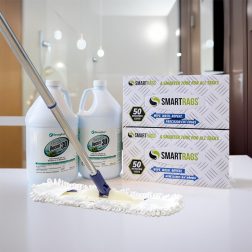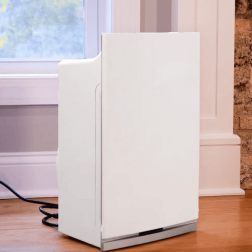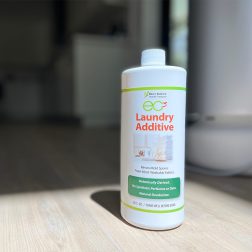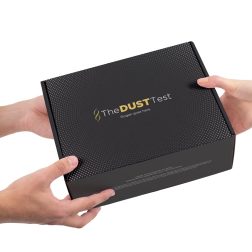No products in the cart.
Mold Resources
Knowing how to remove mold from clothes is a great way to ensure you’re not dealing with unwanted exposures from your wardrobe.
Is Mold on Clothing Harmful?
The simple answer is yes. As soon as that mold grows, it releases spores (and potentially toxins) into the surrounding environment. That means the air around the individual with moldy clothes is contaminated, and the garment is also filled with harmful particles.
The size of the specks involved is the key to mold’s ability to cause problems. They’re small enough to be inhaled, ingested, and absorbed. That means that when you’re wearing an article of clothing with mold or something cross-contaminated, you can experience high levels of exposure.
How to Remove Mold From Clothes
Sadly, the best way to remove mold from clothes is to throw that contaminated item out.
Once mold colonizes, its roots grow deep into the fibers of whatever surface it’s on. For porous items like clothing, this leads to moldy roots throughout the garment's fibers. On the other hand, living mold also releases spores and potentially toxic chemicals into the surrounding area and into the clothing item. Thanks to their small size, many of these particles can embed themselves deep within the fabric's fibers as well.
This infestation of moldy particles makes it incredibly difficult to decontaminate the item completely. For hypersensitive individuals feeling the effects of toxicity, any exposure to these particles can allow those chronic symptoms to continue. As the EPA says, even dead mold can trigger adverse health reactions, which is why bleach is not on the recommended list for mold-fighting products.
If you are dead-set on trying to remove mold from clothing and as much contamination as possible, you can try washing the garment multiple times in the laundry with EC3 Laundry Additive. That being said, pay attention to how you feel around the garment because there will still be some contamination present that can trigger adverse health reactions.
How to Remove Mold from Clothes Part 2: Find the Source
One of the top priorities during this process is finding the source that led to the mold in the first place. It could just be the result of a wet garment and a lucky mold spore, but check wherever the clothing is kept to determine if there’s a leak or some other moisture-related event. It’s always better to be safe than sorry.
If mold on clothes continues to be an issue, but you can’t find the problem, use The Dust Test to start your journey to finding answers.
Showing the single result
How to Prevent Mold on Clothes
While knowing how to remove mold from clothes is important, the best way to deal with this issue is to prevent it from occurring in the first place.
Steps to prevent mold on clothing include:
- Keep clothing dry: Whether getting them out of the dryer or coming in from the rain, ensure that clothing dries quickly and completely before storing them. Mold only needs 24-48 hours to start growing.
- Wash all clothing with a botanical cleaner like EC3 Laundry Additive: Mold spores will inevitably make their way into your clothing. Using a product like EC3 helps remove as many microscopic particles as possible from the garments, reducing the opportunity for mold on clothes.
- Maintaining low indoor humidity: Aim for 35 to 50% humidity. The lower the level, the fewer opportunities for mold to grow. If humidity remains high, consider purchasing a dehumidifier and throwing in desiccants like silica gel packets into the closet, dresser, or storage bin to help remove as much moisture as possible.
- Invest in air purification: Whether a whole-home unit or a portable one for the room, these machines will help remove all those harmful particles from the air, including mold spores. The fewer mold spores in the indoor environment, the fewer opportunities for mold on clothing. Make sure to go with a unit that will actually filter out these particles, though.
- Clean the Storage Areas: Remove all items from the closet, dresser, armoire, etc. Use a HEPA vacuum cleaner on every inch of the space, and then follow up with a botanical cleaner, depending on the surface you’re working on. While cleaning, check for any hidden mold or leaks/water issues that could lead to mold on clothes.
- Prioritize airflow: Creating airflow helps remove humid air and decrease particle buildup. This step can include opening closet doors and drawers, reducing the number of items in direct contact with the floor, and opting for wire racks—whatever you can do to get that air moving.
- Keep dirty clothes out of the closet: Dirty clothes can contain moisture, particles, and mold spores, leading to mold growth and contamination of your clothing storage area. Keeping these separate reduces the risk of cross-contamination and helps keep that indoor environment squeaky clean.
Showing all 3 results
-

HomeCleanse Cleaning
Take your cleaning to the next level buying all the tools we use to keep...
-
$299.00 – $549.00 SHOP NOW -
Sale

Intellipure Compact Air Purifier
Small in size, but delivers powerful results, reducing airborne microorganisms like mold, viruses, and bacteria.
-
Original price was: $549.00.$199.00Current price is: $199.00. SHOP NOW -

EC3 Laundry Additive
Add EC3 to every rinse cycle to rinse away mold, bacteria and musty odors from...
-
$23.00 SHOP NOW
Still Have Questions?
A member of our team is here to help! Click on “Get Started ➤” below to book a consultation with a member of the HOMECLEANSE team. We have a few quick questions that will help us put together a roadmap to solve or prevent all of your mold problems.
Two minutes of your time could lead to better health for you and your family.

